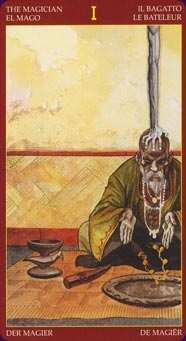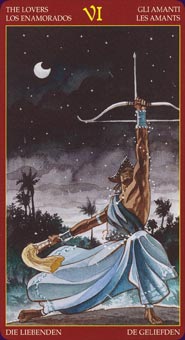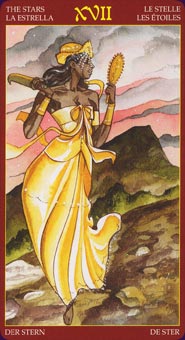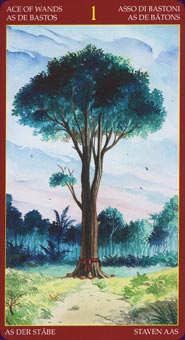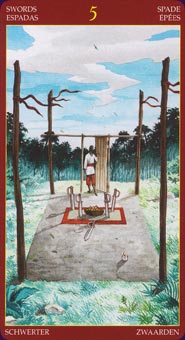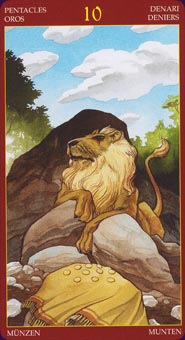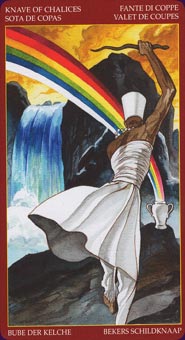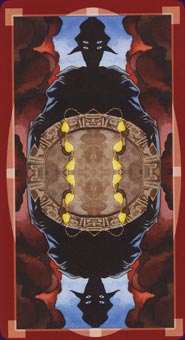Afro-Brazilian Tarot Deck Review
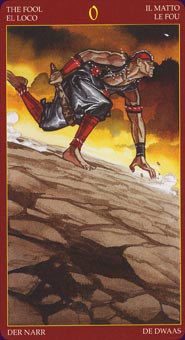
Creators: Giuseppe Palumbo
Publisher: Lo Scarabeo 2006
The Afro-Brazilian Tarot is dedicated to the divinities of the African Yoruban and Brazilian Candomble religions, and combines these and Santeria with the archetypes of tarot.
Retailers
See Price at Amazon.comSee Price at Amazon.co.uk
See Price at Amazon.ca
Afro-Brazilian Tarot Review by Eva Yaa Asantewaa
Giuseppe Palumbo’s Major Arcana imagery is the most successful element of Alice Santana’s Afro-Brazilian Tarot, a new deck from Italian publisher Lo Scarabeo. Palumbo’s watercolor paintings reflect his background in cartoon illustration and tell their stories with bold simplicity and vigorous angularity. A hunky-looking Fool races across sloping ground that crumbles beneath him. In Temperance, a white-clad figure prances over gray, dry land while a rainbow springs from his head towards a roiling sky. As The Sun’s kneeling supplicant raises the palms of his hands towards our huge star, I can almost feel its heat on my own skin. In these images, everything whips up, billows, whirls, twists, pelts, lunges, and surges. This movement aptly represents a culture that respects, channels, and dances the fundamental forces of nature.
Santana envisions her deck as a synthesis between Tarot’s classic archetypes and the Yoruban traditions of reverence for primary spirit beings known as orixas that West African slaves brought to the Western Hemisphere. Her deck contains the standard Tarot breakdown of twenty-two Major Arcana and fifty-six Minor Arcana cards. The imagery is Afro-Brazilian but the cards bear traditional Tarot names like The Lovers, The Hermit, the Ace of Pentacles, and the King of Swords. In accordance with Lo Scarabeo’s standard format, these names are printed in English and several European languages in the cards’ margins. The corresponding orixa names do not appear on the cards but are listed in the Little White Book’s brief section on the Major Arcana.
Correspondences between these two systems--Tarot and African Brazil--sometimes work well. Yemanjá, motherly orixa of the ocean and its abundance, certainly is a reasonable match for Tarot’s Empress, the nurturing Earth Mother of all things. Other comparisons seem less evident. It’s not immediately clear why Santana and Palumbo associate the Ibeji–the spirits of twin children, symbolizing duality–with Tarot’s Chariot. Perhaps they equate the twins with the charioteer’s two horses shown in the traditional design of a Rider-Waite deck or one of its clones. Lo Scarabeo’s slapdash, sometimes strangely translated Little White Book (LWB) does not help: “Orixá the child represents twins, therefore the dualities shadow and reflection, body and soul. Travel, dynamism, success” (p. 6). Those keywords, italicized by Santana, indeed refer to Tarot’s Chariot, but without further information or insight, it’s hard to see why a picture of empty-eyed twin kids gazing at a fire suggests travel, dynamism, and success. This deck actually works best if the reader has at least a passing knowledge of Yoruba-based religions and is capable of momentarily ignoring much of what he or she knows about Tarot. The Tarot stuff–at least as rendered here–often gets in the way.
The LWB’s interpretations and keywords for the Minor Arcana seem to relate solely to Tarot, and in the most generic way. Take the Two of Chalices (Cups) where Palumbo offers us a fresh approach. Lush tropical leaves rise behind two white urns set up on a boulder overlooking a river. In the water, a tortoise sits on a big rock, a frog clings to the tortoise’s back, and an exotic red bird perches atop the frog. The LWB, however, tells us only that the card means “love, happiness, encounter, friendship, union” (p.7) These keywords could be used for the Two of Cups in any Lo Scarabeo deck. They offer nothing specific either about African-Brazilian lore or Palumbo’s wonderfully unexpected image.
According to the LWB, the Four of Chalices represents “boredom, restlessness, tiredness, malaise, dissatisfaction” (p. 8), but Palumbo’s neutral image simply shows two women lifting urns towards each other while two urns sit atop a shelf. If I stretch a bit–quite a bit--I can make this image fit its LWB interpretation but why bother? Reaching the Five of Chalices–where an orange tabby strolls across a table, toppling one of five urns–I ignored the LWB and assigned my own meaning: “Mischief!”
Palumbo’s Minor Arcana cards tend to be calmer and in a few cases prettier than his Majors, although too many are aesthetically flat, unimaginative, and awkward. Many Tarot illustrators give their all to the Majors and then have little or nothing left for the Minor Arcana. Palumbo, is no exception.
A substantial guidebook could expand on this deck’s interpretations and give readers a baseline grounding in Afro-Atlantic spirituality: its philosophy, legends, and practices. One glaring mistake on Lo Scarabeo’s box should be corrected: Its text refers to “Afro-Brazilian Santeria.” Santeria is an African-based religion developed in Cuba not Brazil, a distinction Santana makes clearer in the LWB. It’s also sad and puzzling that Santana–a Brazilian-born initiate of Candomblé living in Rome–decided to smear voudon, the Afro-Atlantic religion of Haiti by writing that unlike the “bright and benign vision” of Brazilian Candomblé and Cuban Santeria, voudon evolved from Yoruba in “a more obscure and disturbing direction” (p.3). How ironic that Santana has apparently adopted a European and American prejudice often directed against all African-based religions–including her own--not merely voudon.
© August 2006
Afro-Brazilian Tarot Review by Kim Huggens
“The divinities of Afro-Brazilian Santeria, tied with the immortal archetypes of the Tarot”
The front of the box says it all. This deck takes the deities (called orisha) of Santeria religion, and expresses them through the archetypes of the Tarot's Major Arcana. This works both ways: a Tarot enthusiast will better understand Santeria deities through their links with the Major Arcana, and a practitioner of Santeria will quickly become familiar with the Tarot through it's links with their Gods. Unfortunately, this means the deck is not one for beginners of Tarot. Then again, do we want all Tarot decks to be aimed at beginners? There is certainly a call in the market for decks that can afford to throw in more advanced ideas and symbolism, and the Afro-Brazilian Tarot is one of them.
Few decks out there cater to non-Western belief systems and mythologies, leaving many people disappointed and feeling under-represented. Santeria in particular is unknown to most people (especially here in Britain), yet the practitioners of this religion have a rich understanding of the concept of divination, with their own native divinatory tradition being the ancient Ifa. Hopefully, the Afro-Brazilian Tarot will allow practitioners of Santeria the opportunity to learn and use Tarot in a way that is relevant to their way of life, spirituality, and connection with the Divine. (Just to note: there are a few decks available at the moment that focus on Haitian and New Orleans Vodou, and whilst Vodou and Santeria have things in common and share some deities, they are quite different.)
The deck itself is traditional in that it has 22 Major Arcana, 56 Minor Arcana, four suits, and the numbering of the Majors is kept the same (with VIII as Justice and XI as Strength). However, the imagery within each card has changed from the well-known Rider Waite Smith quite drastically, and the deck (thankfully) lacks any of the overly complex occult symbolism of decks such as the Crowley Thoth. The images and symbolism has instead been changed to reflect Santeria deities, beliefs, and practices – making this deck Santeria through and through. For instance, I The Magician (usually depicted as a conjuror by a table laden with his magical tools, directing magical energy) has become an image of a Babalawo (Priest) consulting Ifa, the hand of Orunmila (the Santeria orisha of divination and priests) upon his head. He no longer channels his own energy like the Magician does – he channels the wisdom of Orunmila. His divinations for his congregation members allow them to take action in their lives, find the source of their problems, and serve their Gods in the most appropriate way.
There are some excellent choices of deities for the Major Arcana in this deck (such as Yemanja, orisha of the primordial ocean, for III The Empress, and Eshu as O The Fool) but I was personally hoping to see some more myths and stories in the cards. It seems many of the deities have been chosen because of their attributions (e.g. Ogum, the orisha of war and iron, for IV The Emperor) instead of any particular stories they took part it that reflect the card's meaning. However, that's just a personal preference, since I am a great lover of stories and myths. In places as well, the choices of orisha are excellent but are not explained very well for those who are as familiar with Tarot and Santeria. For instance, the divine twins the Ibeyi have been chosen for VII The Chariot, because “... Orisha the child represents twins, therefore the dualities shadow and reflection, body and soul.” This might seem puzzling to some readers, until they realize that the tradition Rider Waite Smith image of this card is of a chariot being pulled by two creatures: one white and one black. This has lead to interpretations of this card as representing the duality of the soul or of life: the dark and the light. But it's certainly not the traditional interpretation of that card, and one that is quite unknown to most.
The Minor Arcana are Swords, Wands, Chalices, and Pentacles, and because many of the card images depict lush nature, there is some absolutely stunning artwork here (my personal favourite being the Three of Cups.) The Minors do not have orisha associated with them, but instead show more everyday aspects of Santeria: traditions of divination, making offerings, social situations and home concerns. Throughout each suit colours and settings remain similar, adding a useful continuity to the cards. There also seem to be some figures appearing in more than one card, serving to create a world within this deck that you feel as though you can enter and walk around in. However, there are some images in the Minors that would be confusing to those unfamiliar with Santeria: items are depicted that are completely alien to me, though I am sure would be full of meaning for practitioners of the religion.
The artwork itself (done in watercolours) is beautiful and full of colour and detail that makes this deck come to life. In places it seems to become a little manga-esque and stylized, but it gives the deck a little bit of an interesting twist.
Unfortunately, there is no companion book for this deck, so the rich tapestry of deities and traditions of Santeria as shown in this deck will have to be researched by the user of the deck. Considering the depth of the imagery here, and of the tradition of Santeria itself, I think such research would be well-justified for anybody wishing to use or understand this deck further.
In places the Afro-Brazilian Tarot moves away from commonly known Rider Waite Smith meanings, mostly because this isn't another Rider Waite clone. The original imagery and symbolism reflects the fact that this is a deck aimed at, and depicting, a completely different culture to the one in which the Rider Waite tradition flourished. And since variety is the spice of life, I think the Afro-Brazilian Tarot, whilst not being a beginner's deck, adds something new and interesting to the Tarot world.
Complete Details of Afro-Brazilian Tarot
Creators: Giuseppe PalumboPublisher: Lo Scarabeo 2006
Deck Type: Tarot Deck
Cards: 78
Major Arcana: 22
Minor Arcana: 56
Deck Tradition: Mixed
Minor Arcana Style: Illustrated
Suits: Chalices, Pentacles, Swords, Wands
Major Titles: Knave, Knight, Queen, King
Strength is 11
Justice is 8
Card Size: 2.60 x 4.72 in. = 6.60cm x 12.00cm
Card Language: English
Card Back: Reversible
Back Design: Mirrored image of a shadowy figure against red clouds and blue sky.
Companion Material: Little white booklet.
Rating: 14/20 or
Similar Decks to Afro-Brazilian Tarot
Theme: African, South & Central AmericanCategory: Available Tarot Decks
Creator: Tarot of the Mystic Spiral by Giuseppe Palumbo
< Previous Deck · Back to Top · Next Deck >
Home > Tarot Reviews > Afro-Brazilian Tarot Review

